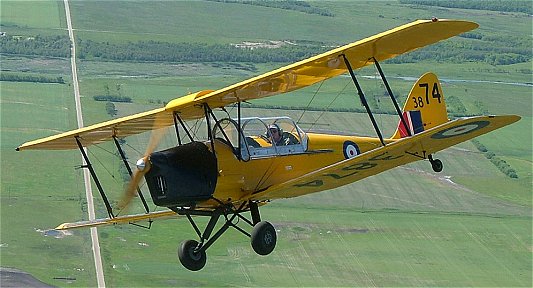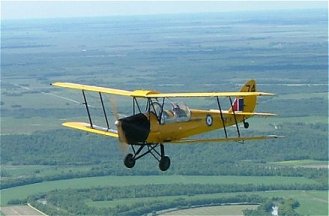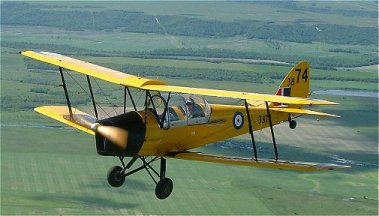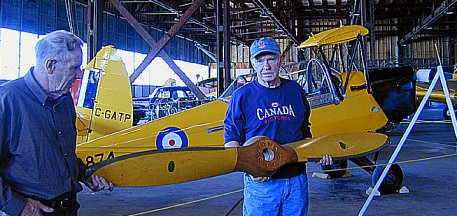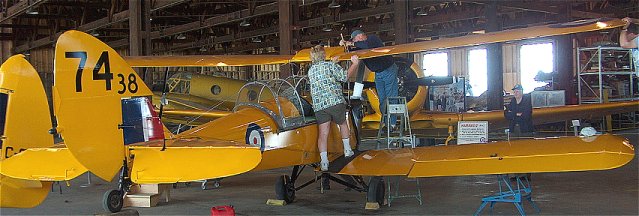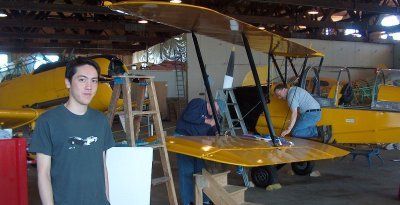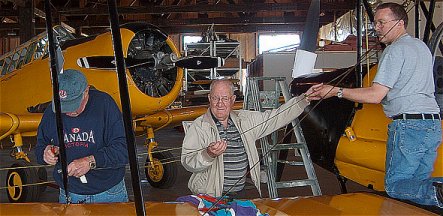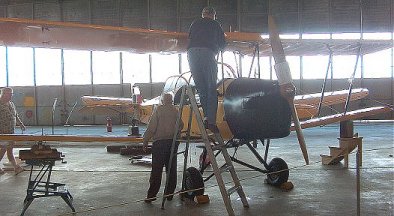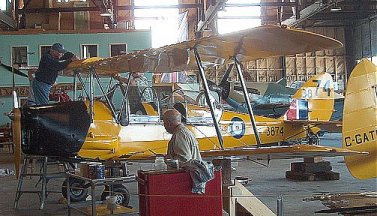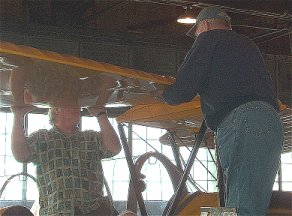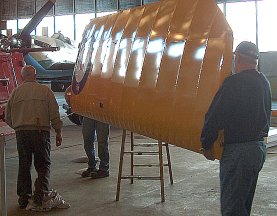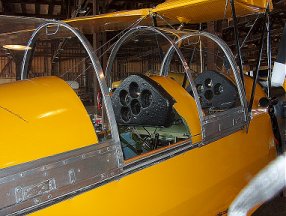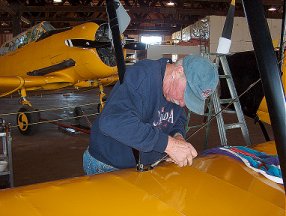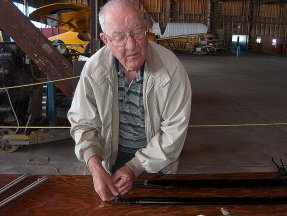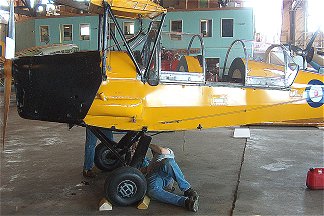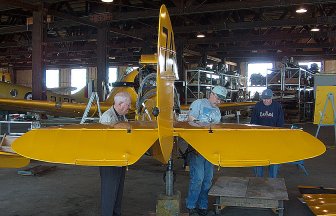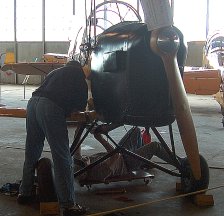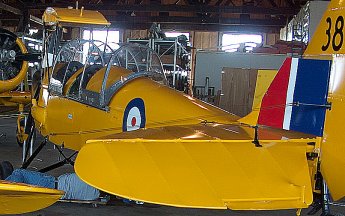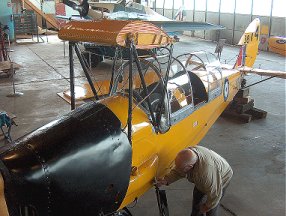Bob landed at Brandon at about noon and taxied
to the Commonwealth Air Training Plan Museum (CATPM) at the airport. www.airmuseum.ca
At the time, the museum's Fairchild Cornell trainer was on the ramp giving
museum volunteers rides.
Museum president John McNarry, and Stephen Hayter, the
general manager were on hand to meet him.
"When I arrived, John McNarry came over and asked me 'Does
your Tiger always sound like that?” recalls Bob. "I didn't know what he
meant, but when I took off my headset I could hear quite a racket. There
was a large knock coming from the engine of the Tiger."
"It sounded serious and we needed to check it out. The
first thing I did was call Cecil Pittman up in Neepawa to tell him that
the aircraft was 'sick' and unlikely to make it to the community celebration
he had planned in Neepawa for Sunday."
The aircraft was pulled into the hangar at the museum
and Bob and John started removing the cowlings to get access to the engine.
They suspected a bearing problem, but wouldn't know for sure until they
got access to the inside of the engine.
While they were working, Brent Fitzpatrick from CKX TV,
a CTV affiliate station showed up to report on Bob's flight and the latest
challenge in the journey.
When Bob got to the RV park that night he was absolutely
bushed. It had been a long day of flying and trouble shooting, and he was
still uncertain as to the problem.
Sunday June 27
The original plan for Sunday was a short flight to Neepawa
where Bob's aircraft was stationed during the later part of the war with
No. 35 (RAF) and No. 26 Elementary Flying Training School. Local historian
Cecil Pittman had been corresponding with Bob for several years, and had
mobilized the community for the homecoming of the Tiger Moth.
Instead, Bob and McNarry were in the hangar at Brandon
trying to tear down the engine. They reached an impasse when they discovered
they could make no further progress without a special tool to pull the
propeller hub of the D.H. Gipsy Major 1C engine.
The publicity of the Tiger Moth flight across the Prairies
and the aircraft's arrival in Brandon stimulated considerable community
interest, and the Tiger Moth received a steady flow of visitors while on
display at the Brandon museum.
While they were working on Sunday, Archie Londry, past
president of the Museum, visited the hangar with his logbook. In Bob's
presence, he opened to the page where he had flown Tiger Moth No. 3874
at No. 19 EFTS at Virden in December 1942.
Monday June 28
"Monday was an incredible day," says Bob Laidlaw.
"When I got up in the morning, I called Ed Clark, my engine
man in Hawthorne, California for advice. Ed rebuilt my engine and confirms
that we need a special tool to pull the propeller hub."
"John McNarry teaches machine shop at a local college.
On hearing this, he goes down to the college, which is closed for the summer,
and he spends the next five hours making the tool we need!"
"We took it back to the airport and got the hub off. You
need to get the hub off, to remove a seal, which sets off a chain reaction
of parts and allows you to remove the top cover of the engine."
“The whole exercise was anticlimactic because we got the
top off and couldn't find a darn thing wrong with the engine.”
Tuesday, June 29
Bob and John worked on the engine the entire day. They
put it back together, and by Tuesday night were ready to do some ground
runs on the ramp at Brandon. Bob started the engine and it ran as
rough as ever.
Wednesday, June 30
The next morning, a local Aircraft Maintenance Engineer
(AME) inspects the engine with a bore scope but is unable to determine
the problem. Visitors speculate that it might be a connecting rod, or a
pin or a misfiring cylinder.
“We were working the problem too much,” said Bob “and
we needed to step back and take a large view of the problem.
“We didn’t know what was wrong with the engine, and we
were unable to find out what the problem was by tearing the engine apart.
We were not in a environment conducive to figuring out the problem, and
we were up against a holiday weekend if we wanted to have parts couriered
from the United States.
“Ed Clark reminded me that the Gipsy Major in the aircraft
is 80 years old, and there are not too many people around who know how
to fix one.”
“Even if we change parts in the engine, or got another
engine, we still had to fly across the wilds of northern Ontario to get
to Toronto.”
“It would be nice to make this journey home to Toronto
by air, but the most important objective was to get the aircraft to Toronto
in one piece and on time.”
“I reviewed the situation, and decided that the aircraft
better make the rest of the trip to Toronto by truck or train,” said Bob
Laidlaw.
Bob called Paul Cabot at the Toronto Aerospace Museum
and told him to start getting quotes to have the aircraft shipped from
Brandon to Toronto.
Thursday, July 1
Bob Laidlaw and his wife Nell were invited to Neepawa
to participate in Canada Day celebrations. They met Cecil Pittman, whose
grandfather had the farm adjacent to RAF Station Neepawa.
Cecil has done a lot of work to commemorate the history
of the flying school in the town. Bob and Nell were shown a granite memorial
bench in front of the courthouse in the town, and they visited the local
cemetery were seven airmen killed in wartime accidents at the station are
buried.
Bob and Nell were treated royally by the town, and attended
the annual community BBQ and shook lots of hands. Bob also made a courtesy
visit to the local nursing home to visit a local RCAF veteran who had flown
Tiger Moths during the war at No. 26 EFTS. He pulled out his logbook,
but they didn’t find No. 3874 listed, but a sister ship No. 3882.
Impressed with the hospitality, Bob invited Cecil and
the folks of Neepawa to visit Brandon and see the aircraft on Friday and
Saturday before he started dismantling the aircraft for its journey by
surface means to Toronto.
Calling back to Toronto, Bob alerted the Toronto Aerospace
Museum of his desire to fly the Tiger Moth in Toronto if the loan of an
Gipsy Major 1C engine could be arranged.
Friday and Saturday July 2-3
Publicity during the week brought at lot of visitors from
Neepawa and other communities to the museum in Brandon to see the Tiger
Moth. Bob spent a solid two days meeting visitors and telling the story
of the Tiger Moth, and his flight again (and again).
Sunday July 4
A decision was made to ship the aircraft to Toronto by
CN inter-modal. CN would send a truck and 43 ft long trailer to Brandon
to pick up the aircraft, and the trailer would be loaded on a railway car
in Winnipeg for the rail journey to Toronto.
Bob, John and a group of volunteers began dismantling
the aircraft of Sunday morning so it would be ready to load in the trailer
on Monday morning.
